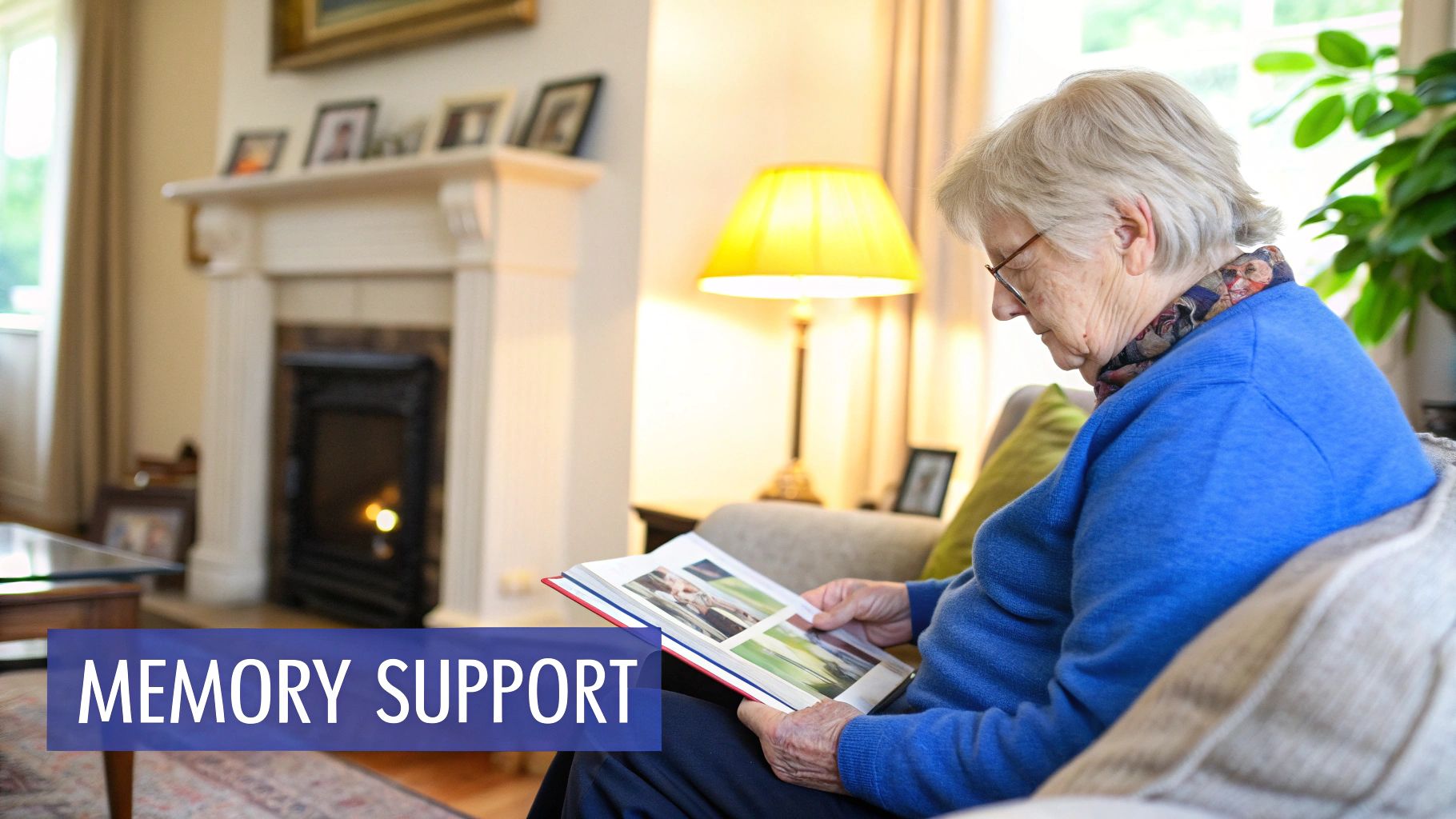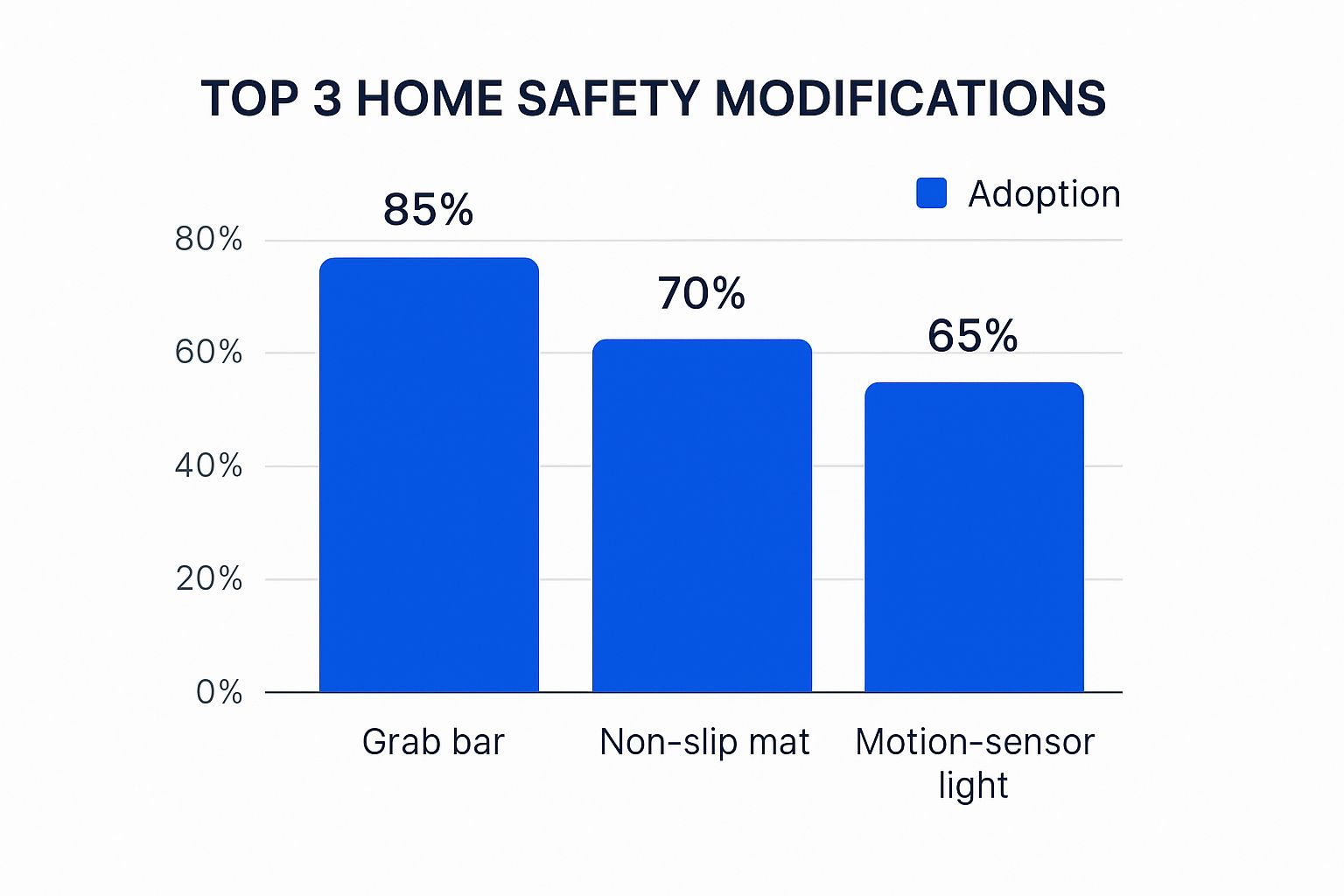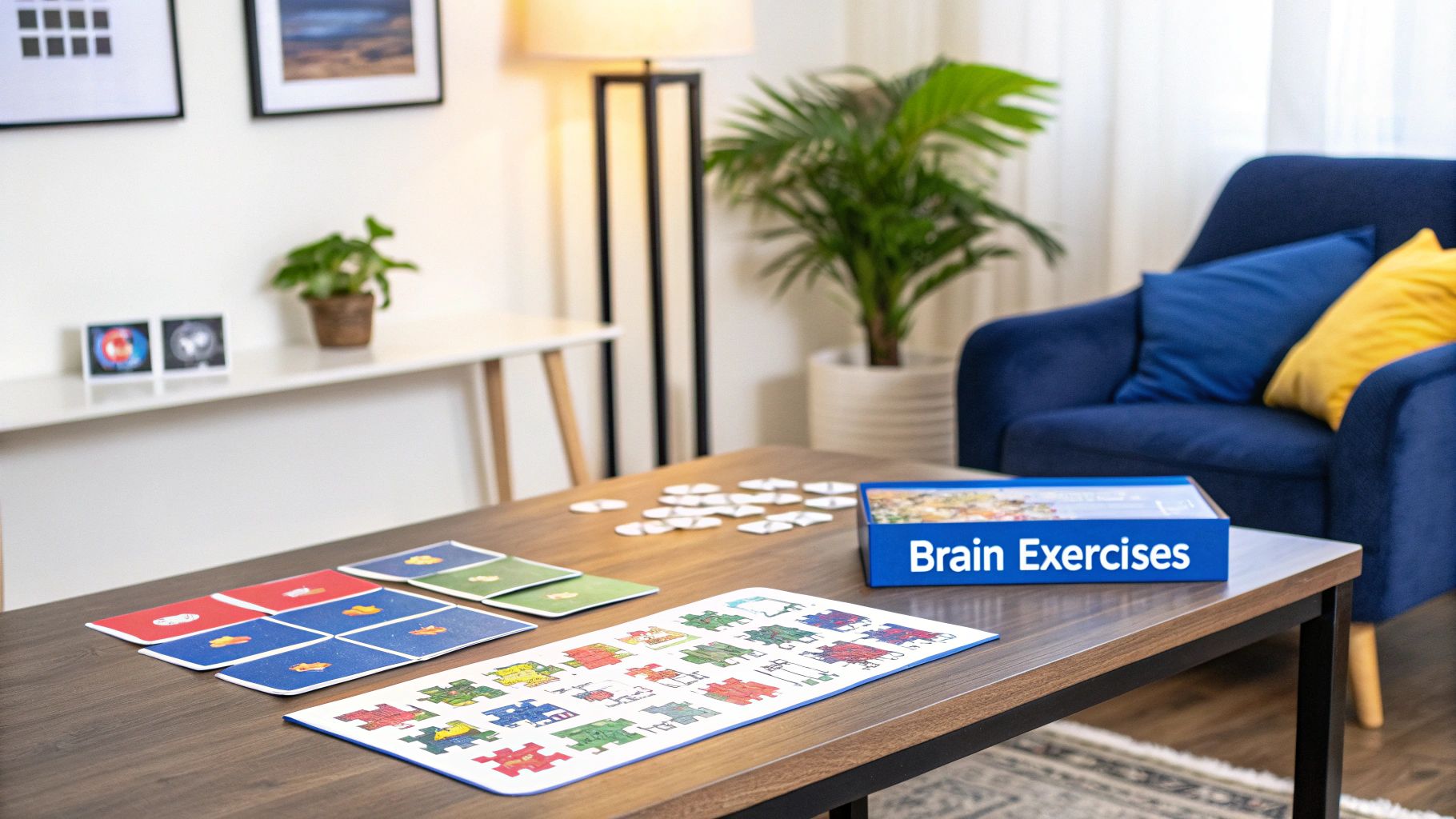Navigating the Alzheimer's Care Journey at Home

Providing Alzheimer's care at home can feel overwhelming. Understanding the journey and its challenges can empower you to provide compassionate and effective care. Focusing on a supportive and loving home environment is key. You might be interested in: In-Home Care For Alzheimer's Patients.
Understanding the Stages and Evolving Needs
Alzheimer's progresses through stages, each with unique challenges. Initially, memory lapses and confusion may be subtle. As the disease advances, these intensify, affecting daily life.
Simple tasks, such as dressing or cooking, can become difficult. This requires a flexible approach to home care.
The Importance of Familiar Surroundings
A familiar environment is vital for individuals with Alzheimer's. This offers comfort and reduces anxiety.
Familiar objects and routines can help maintain a sense of identity and independence. This becomes especially important as disorientation increases.
Technology, like health tracking wearables, can also play a role in monitoring and care.
The Emotional Impact on Families
Home care for Alzheimer's patients significantly impacts families emotionally. Witnessing a loved one's decline is difficult.
Open communication and emotional support are essential for both the caregiver and the individual with Alzheimer's. Shared activities, even simple ones, can strengthen bonds and create positive moments.
Family and unpaid caregivers are crucial. Nearly 12 million caregivers provided about 19.2 billion hours of care in 2024. While the number of caregivers has decreased, the care provided by each has increased, highlighting the reliance on informal home care. An estimated 7.2 million Americans 65 and older have Alzheimer's, a number projected to almost double by 2060. Learn more about Alzheimer’s statistics.
Adapting Your Approach Over Time
Caregiving strategies need to adapt as Alzheimer's progresses. This may include home modifications for safety, adjusting communication, or seeking help from professional caregivers.
Recognizing caregiver burnout is also vital. Breaks, support groups, and self-care are essential for sustainable caregiving.
Transforming Your Home for Safety and Comfort
Creating a safe and comfortable home for someone with Alzheimer's goes beyond preventing accidents. It's about fostering independence and dignity while providing essential support. Adapting the home to meet evolving needs significantly improves the quality of life for both the individual and their caregivers.
Simple Changes, Big Impact
Often, the most effective modifications are surprisingly simple and affordable. Improving lighting can reduce disorientation and the risk of falls. Consider adding nightlights in hallways and bathrooms, and be sure to remove clutter from walkways. These are easy first steps with a big payoff. Installing grab bars in the bathroom and using non-slip mats can also dramatically increase safety during bathing. These small changes can have a profound impact on maintaining independence and preventing injuries.
The following infographic visualizes the adoption rates of some common home safety modifications.

As the infographic shows, 85% of caregivers have installed grab bars, making them the most widely adopted modification. Non-slip mats follow at 70%, and motion-sensor lights at 65%. This data suggests a strong focus on bathroom safety and fall prevention.
Adapting to Cognitive Changes
As Alzheimer's progresses, cognitive abilities change, requiring further adaptations. Clearly labeling drawers and cupboards with pictures or words can help individuals locate items independently. Removing or securing potentially hazardous items, like cleaning supplies and medications, is also crucial. Think of these changes as creating a gentle, supportive guide within the home, allowing the individual to navigate their space with more confidence and less confusion.
Addressing Wandering and Safety Concerns
Wandering is a common challenge in Alzheimer's care. Securing doors and windows with locks that are difficult for someone with dementia to operate can help prevent unsupervised exits. Consider installing alarms that notify caregivers if a door is opened. These measures offer peace of mind and reduce the risk of the individual becoming lost or injured.
To help illustrate practical modifications that enhance safety and improve the living environment for individuals with Alzheimer's, the following table provides a room-by-room breakdown of common hazards and solutions:
Essential Home Safety Modifications for Alzheimer's Care
| Room/Area | Common Hazards | Recommended Modifications | Approximate Cost |
|---|---|---|---|
| Bathroom | Falls, scalding, difficulty bathing | Grab bars, non-slip mats, shower chair, adjustable shower head, temperature regulating valves | $50 – $500 |
| Bedroom | Falls, disorientation, wandering | Nightlights, clear pathways, bed rails, door alarms, removing tripping hazards | $20 – $300 |
| Kitchen | Burns, cuts, poisoning, difficulty cooking | Stove guards, automatic shut-off devices, removing hazardous items, organizing cupboards | $30 – $200 |
| Living Room | Falls, disorientation, wandering | Removing clutter, securing furniture, good lighting, familiar objects | $10 – $100 |
| Exterior | Wandering, falls | Fencing, secured gates, motion-sensor lighting, clear pathways | $100 – $1000+ |
This table highlights the range of modifications available, from simple, low-cost solutions to more extensive adaptations. Remember to prioritize modifications based on individual needs and existing home layout.
Creating a Calming Atmosphere
A calm and predictable environment can significantly reduce agitation and anxiety. Soft lighting, calming colors, and familiar music can create a soothing atmosphere. Minimizing noise and distractions, like loud televisions or excessive clutter, contributes to a more peaceful setting. This approach recognizes the importance of sensory input and its impact on individuals with Alzheimer's.
Integrating Technology Strategically
Technology can be a valuable tool in Alzheimer's care. Motion sensors can alert caregivers to nighttime wandering, and medication dispensers can improve adherence. GPS trackers can provide an extra layer of security if wandering is a significant concern. These tools offer practical solutions, but it's essential to choose technology that enhances, not complicates, care.
By carefully considering the individual's needs and implementing these modifications, we can transform the home into a haven of safety, comfort, and preserved dignity. This proactive approach empowers independence while providing the necessary support for a fulfilling life at home.
Building Daily Routines That Actually Work

Establishing consistent daily routines is fundamental to effective Alzheimer's care at home. This structure offers a sense of predictability and normalcy, reducing anxiety and improving well-being for individuals with Alzheimer's. These routines become anchors, providing comfort and stability amidst cognitive changes.
The Power of Predictability
Predictable routines offer a vital sense of security. For someone navigating cognitive decline, the world can feel increasingly disorienting. A structured daily routine offers a sense of control, reducing feelings of overwhelm. This isn't just about scheduling; it's about establishing a reassuring daily rhythm.
For example, consistent wake-up times, meals, and bedtime routines can regulate sleep and minimize sundowning, where symptoms worsen in the late afternoon and evening. These routines also create valuable opportunities for meaningful engagement and connection.
Creating a Flexible Framework
While consistency is key, flexibility is also crucial. Abilities can fluctuate daily for someone with Alzheimer's. A rigid schedule can cause frustration and resistance. Routines should be adaptable, adjusting to individual needs and moods. This adaptability helps maintain a positive caregiving environment.
Caregivers should be ready to modify activities, adjusting their length as needed, or even skipping parts of the routine on challenging days. This responsive approach emphasizes understanding and support.
Communication Strategies for Connection
Communication is the cornerstone of any relationship, especially when caring for someone with Alzheimer's. As verbal communication becomes more difficult, understanding non-verbal cues, such as facial expressions and body language, becomes essential. Interpreting these cues helps caregivers respond to unmet needs and emotional states. This attentive communication strengthens the caregiver-patient bond.
Using simple, clear language, speaking slowly, and maintaining eye contact can facilitate understanding. Validating feelings and offering reassurance can ease anxiety and build trust. These communication strategies are vital for a supportive and empathetic caregiving environment. Globally, access to formal Alzheimer’s care is a significant challenge, with many receiving little to no support. Find more detailed statistics here. This highlights the importance of effective at-home care.
Practical Strategies for Daily Activities
Developing practical strategies for everyday tasks is essential for at-home Alzheimer's care. Breaking down activities into smaller, manageable steps makes them less daunting. Instead of saying "get dressed," a caregiver might say, "Let's put on your shirt," then "Now, let's put on your pants." This step-by-step approach promotes independence and reduces frustration.
-
Morning Routine: A consistent morning routine sets a positive tone for the day. This could include gentle waking, assistance with dressing and grooming, a light breakfast, and a calming activity like listening to music or looking at photos.
-
Mealtimes: Mealtimes can become challenging. Offering finger foods, adaptive utensils, and a calm dining environment can make them more enjoyable.
-
Bathing and Hygiene: Bathing and hygiene should prioritize comfort and dignity. Warm water, reassurance, and offering choices can make these activities more pleasant.
-
Evening Routine: A relaxing evening routine promotes better sleep. This might include a warm bath, calming music, or reading a familiar book.
Modifying familiar activities to match current abilities is also key. This could involve adapting hobbies, simplifying games, or finding new engaging activities. Creating meaningful moments within care tasks, like singing while dressing or reminiscing while cooking, can enhance quality of life. By implementing these strategies, we can create a supportive and engaging environment that fosters a sense of purpose and well-being.
Responding to Challenging Behaviors With Confidence
Alzheimer's disease often brings behavioral changes that can be difficult for caregivers. These behaviors, such as agitation, resistance to care, and sundowning, are often expressions of unmet needs or an overwhelming environment. Understanding the reasons behind these behaviors is the first step towards responding effectively.
Decoding the Behaviors
Challenging behaviors aren't simply symptoms of the disease; they are a form of communication. Imagine a person with Alzheimer's struggling to express their thirst or discomfort. This inability to communicate basic needs can manifest as agitation or restlessness. By viewing these behaviors as attempts to communicate, caregivers can approach them with empathy and understanding.
Additionally, consider the environment. A noisy or overly stimulating environment can be distressing for someone with Alzheimer's, triggering anxiety or confusion. For example, a crowded room or a loud television may contribute to agitation. This emphasizes the importance of creating a calm and supportive atmosphere.
Personalized Intervention Strategies
There is no one-size-fits-all approach to managing challenging behaviors in Alzheimer's care at home. Effective interventions are personalized, addressing the individual's specific triggers and needs. This requires careful observation and documentation of behavior patterns. Keeping a journal noting the time of day, environment, and potential triggers can reveal patterns that inform effective strategies.
For instance, if sundowning is a recurring issue, creating a calming evening routine can be beneficial. This might include dimming lights, playing soft music, and engaging in relaxing activities. If bathing is a source of anxiety, adjusting the water temperature, providing extra reassurance, and offering choices can make the experience less stressful.
Non-Pharmacological Approaches That Work
Non-pharmacological approaches are often the first line of defense in managing challenging behaviors. These interventions focus on addressing the underlying causes of the behavior, not just the symptoms. They promote dignity and well-being.
-
Sensory Engagement: Activities that engage the senses, such as aromatherapy, hand massages, or listening to calming music, can be incredibly effective in reducing agitation and promoting relaxation.
-
Strategic Redirection: Redirecting attention away from the source of distress can de-escalate challenging situations. If someone becomes fixated on leaving the house, gently redirecting their attention to a familiar activity, like looking at photos or folding laundry, can help.
-
Validation Therapy: Validating the person's feelings and emotions, even if they don't seem rooted in reality, can be comforting. This approach acknowledges their emotional experience without arguing or correcting them.
Creating Effective Response Plans
Consistency is key when implementing behavioral interventions. Developing a written response plan, shared with all caregivers, ensures a unified approach. This plan outlines specific strategies for common challenging behaviors, providing clear guidance and promoting consistency.
This plan should also address safety concerns. If behaviors pose a risk to the individual or others, knowing when and how to seek professional intervention is crucial. While managing behaviors at home is often possible, there are times when additional support is necessary.
Preserving Dignity While Managing Challenges
Responding to challenging behaviors with confidence requires a balance between managing safety concerns and preserving the individual's dignity. Every interaction should be approached with empathy and respect. Focusing on the person, not the disease, reinforces their value and worth. By understanding the underlying causes of challenging behaviors and implementing personalized strategies, caregivers can provide compassionate and effective care while maintaining a positive and supportive home environment.
Navigating the Financial Landscape of Home Care

Planning for in-home Alzheimer's care requires careful consideration of the financial aspects. The costs can be substantial, so developing a solid financial plan is essential. This involves exploring various funding options, understanding insurance coverage, and thinking about the long-term financial implications. For those seeking more information on home health care options, Home Health Care For Seniors offers valuable insights.
Understanding the Costs of Alzheimer's Care at Home
Several factors contribute to the total cost of Alzheimer's home care. It's important to understand these contributing factors to create a realistic budget.
-
Professional Caregiving Services: One of the most significant expenses is hiring professional caregivers. Whether you need a few hours of care per week or 24/7 support, the costs vary based on the level of care required and your location.
-
Home Modifications: Adapting your home for safety and accessibility can also add to the initial costs. This could include installing grab bars, ramps, or other modifications to make the home safer and easier to navigate.
-
Medical Supplies and Equipment: The costs of essential medical supplies and equipment, such as incontinence products, medications, and specialized equipment, can accumulate significantly over time. Be sure to factor these ongoing costs into your budget.
-
Respite Care: Respite care provides essential breaks for family caregivers. While invaluable for caregiver well-being, these services also come with associated costs that need consideration.
These expenses can quickly accumulate, emphasizing the importance of financial planning in the caregiving journey. Creating a budget and researching available funding options are crucial steps.
Exploring Funding Options and Insurance Coverage
Fortunately, several funding sources can help families manage the costs of Alzheimer's home care. Exploring these options is a vital part of financial planning.
-
Long-Term Care Insurance: While long-term care insurance can be expensive, it can potentially cover a portion of home care costs. It’s crucial to understand the long-term care insurance cost implications and plan accordingly.
-
Medicare and Medicaid: Medicare and Medicaid might cover some aspects of care, such as skilled nursing or therapy services. However, coverage for long-term home care is typically limited.
-
Veteran's Benefits: Veterans may be eligible for benefits that can help offset some home care expenses. It's essential to explore these benefits if applicable.
-
Financial Assistance Programs: Various state and local programs offer financial assistance for Alzheimer's care. These programs may cover specific services or provide grants to help manage costs.
Understanding each program's coverage is essential for maximizing available resources. Navigating eligibility criteria and the application process can be complex. Insurance coverage for Alzheimer's home care can also be intricate and vary significantly between plans. Consulting with a financial advisor or an elder law attorney specializing in Alzheimer's care can offer valuable guidance.
The following table provides a comparison of various funding options:
Comparison of Funding Options for Alzheimer's Home Care
This table compares various funding sources for home-based Alzheimer's care, including eligibility requirements and services covered.
| Funding Source | Eligibility Requirements | Services Covered | Application Process | Limitations |
|---|---|---|---|---|
| Long-Term Care Insurance | Varies by policy | Varies by policy, often includes home care, assisted living, nursing home care | Application and underwriting process | Can be expensive, waiting periods may apply |
| Medicare | Age 65+ or qualifying disability | Limited home care coverage, primarily skilled nursing and therapy | Enrollment in Medicare | Strict coverage requirements, limited long-term home care coverage |
| Medicaid | Low income and assets | Varies by state, may include home care | Application through state Medicaid agency | Strict eligibility requirements |
| Veteran's Benefits | Veteran status and service-connected disability or age/income requirements | Home care benefits for eligible veterans | Application through the VA | Eligibility requirements vary |
| State and Local Programs | Varies by program, often income-based | Varies by program, may include respite care, home modifications, or caregiver support | Application through the specific program | Limited funding may be available |
This table provides a quick overview of potential funding options. Researching each option in detail based on individual circumstances is crucial.
Legal and Financial Planning
As Alzheimer's progresses, managing finances can become increasingly challenging for the individual. Putting legal and financial arrangements in place early is essential.
-
Power of Attorney: Granting power of attorney authorizes a designated individual to manage financial and legal matters.
-
Advance Directives: Advance directives outline an individual's wishes for medical care and end-of-life decisions.
-
Trusts: Establishing a trust can safeguard assets and ensure funds are used appropriately for the individual's care.
These legal documents are critical for ensuring that financial and healthcare decisions align with the person's best interests as their cognitive abilities decline. They also simplify financial management for family caregivers. The financial burden of Alzheimer's is significant. By 2025, the total cost is projected to reach $384 billion, with lifetime costs estimated at $405,262 per individual, according to statistics found here. Family caregivers frequently bear a substantial portion of these expenses.
Considering the Financial Impact on Caregivers
Caregiving can have considerable financial consequences for family members. Reduced work hours or leaving a job to provide care can lead to lost income and impact retirement savings.
Out-of-pocket expenses not covered by insurance can strain family budgets. Respite care, while beneficial, can create additional financial strain. Recognizing these challenges and exploring financial assistance options for caregivers is crucial for sustainable home care. By carefully evaluating the financial aspects and planning proactively, families can navigate the financial challenges of Alzheimer's home care with greater confidence and ensure the best possible care for their loved ones.
Building Your Caregiver Support System
Caring for a loved one with Alzheimer's at home is a profoundly rewarding, yet challenging, experience. It requires a robust support system to ensure sustainable and compassionate care, not just for the individual with Alzheimer's, but importantly, for the caregiver too.
Recognizing Caregiver Stress
Caregiver stress can manifest in various ways, ranging from physical exhaustion and disrupted sleep to feeling emotionally overwhelmed and socially isolated. Identifying these early warning signs is crucial. Have you noticed increased irritability, difficulty focusing, or changes in your appetite? These could indicate caregiver stress. Ignoring these signals can lead to burnout, hindering your ability to provide effective care.
Prioritizing Self-Care Practices
Self-care isn't a luxury but essential for caregivers. This means incorporating activities that restore your physical and emotional well-being. Even brief periods of self-care can have a positive impact. Consider what genuinely revitalizes you. Perhaps it's a peaceful walk in nature, listening to music, or pursuing a hobby. Just 15-20 minutes devoted to a restorative activity can significantly improve your ability to manage the stresses of caregiving.
Building a Support Network
Sharing the responsibilities of at-home Alzheimer's care is vital. This might involve family members, friends, or professional caregivers. Communicate your needs and limitations openly. Dividing tasks, such as meal preparation, medication reminders, or assisting with bathing, can considerably lessen your burden.
Don't hesitate to seek outside support. Community resources like support groups and adult day care centers provide valuable connections and respite opportunities. Respite care offers temporary relief for caregivers, allowing you to take breaks while ensuring your loved one continues to receive appropriate care. Learn more in our article about Respite Care for Caregivers. When planning for the financial aspects of at-home Alzheimer's care, consider strategies to understand the long term care insurance cost.
Addressing Emotional Complexities
The caregiving journey is often accompanied by emotional complexities. Feelings of guilt, grief, frustration, and even anger are normal. Acknowledging these emotions is essential. Supportive counseling or joining a caregiver support group can offer a safe environment to process these feelings and develop coping strategies.
Maintaining Your Identity and Relationships
Amidst the demands of caregiving, it's important to maintain your own identity and relationships. Schedule time for activities you enjoy, nurture connections with friends and family, and continue pursuing personal interests. This balance is vital for long-term well-being and sustainable caregiving.
Practical Tips for Building Support
- Start small: Begin by identifying a couple of tasks you can delegate.
- Communicate clearly: Openly express your needs and limits with family and friends.
- Explore local resources: Research community support groups and respite care options.
- Set boundaries: Establish clear boundaries between caregiving duties and personal time.
- Prioritize self-care: Schedule regular time for rejuvenating activities.
Building a strong support system is not a sign of weakness, but a testament to your dedication to providing the best possible care. By prioritizing self-care, establishing a network of support, and addressing emotional complexities, you can create a sustainable caregiving experience that benefits both you and your loved one. This support network fosters strength, resilience, and the ability to navigate the Alzheimer's journey with greater confidence and compassion.
Technology That Actually Helps Home Caregivers
Technology offers valuable tools for enhancing Alzheimer's care at home, going beyond basic safety devices. These tools can support independence, improve safety, and lessen the burden on caregivers. It's crucial to choose technology that simplifies, not complicates, the caregiving experience.
Smart Home Systems for Enhanced Safety and Independence
Smart home technology can play a significant role in supporting individuals with Alzheimer's while providing caregivers with peace of mind. Imagine a system that gently reminds your loved one to take their medication or automatically turns off the stove if left unattended. This is the power of smart home systems.
-
Automated Lighting: Motion-activated lights can prevent falls, especially at night. Hallways illuminate as your loved one walks through, minimizing disorientation and reducing fall risks.
-
Smart Locks and Door Sensors: These can alert caregivers to wandering, a common concern in Alzheimer's. You could receive a notification on your phone if a door is opened unexpectedly, allowing for swift action.
-
Voice-Activated Assistants: These can provide reminders for medications, appointments, and daily routines. A gentle voice reminds your loved one to take their medication, creating a supportive structure. Consider using an assistant like Alexa or Google Assistant.
-
Smart Appliances: A smart oven automatically turns off if left on too long, minimizing fire hazards. This is a practical example of technology enhancing safety.
These interconnected systems can create a safer and more supportive home environment, fostering independence and offering reassurance.
Medication Management Technology for Improved Adherence
Medication adherence can be a significant challenge in Alzheimer's care. Forgetting medications or taking incorrect dosages can have serious consequences. Technology can help manage these complex medication routines.
-
Automated Pill Dispensers: These devices dispense the correct medication at the scheduled time, accompanied by reminders. A dispenser lights up and plays a gentle chime, prompting your loved one to take their pills.
-
Medication Reminder Apps: Smartphone apps can send reminders to both the individual and their caregivers, ensuring medications are taken as prescribed. A notification appears on your phone, reminding you to check if your loved one has taken their afternoon medication.
-
Smart Pill Bottles: These bottles track when they are opened and closed, providing valuable data on medication adherence. The bottle records each time it's opened, providing a clear picture of medication usage.
These technologies not only enhance medication adherence but also provide valuable data that caregivers can share with healthcare professionals.
Communication Tools for Maintaining Connection
As Alzheimer's progresses, communication can become increasingly challenging. Technology can help bridge this communication gap, facilitating connection and enhancing emotional well-being.
-
Simplified Video Calling Devices: These devices, with large buttons and simplified interfaces, can help individuals with Alzheimer's connect with loved ones. A video call with family members brings smiles and comfort, despite communication difficulties.
-
Picture-Based Communication Apps: These apps use images and simple phrases to aid communication for individuals with limited verbal abilities. Your loved one can tap a picture of a glass of water to indicate their thirst.
-
Digital Photo Frames: These frames display rotating pictures of loved ones and cherished memories, providing a constant source of comfort and connection. These images spark memories and conversations, fostering connection and reducing feelings of isolation.
Emerging Technologies and Future Possibilities
While these existing technologies offer significant benefits, ongoing research and development continue to push the boundaries of Alzheimer's care. Emerging technologies hold exciting promise for the future.
-
Cognitive Engagement Technologies: Games and apps designed to stimulate cognitive function may help slow cognitive decline and improve quality of life.
-
Virtual Reality for Respite and Engagement: Virtual reality experiences can offer immersive escapes, providing respite for caregivers and engaging activities for individuals with Alzheimer's.
-
AI-Powered Monitoring Systems: Artificial intelligence is being used to develop monitoring systems that can detect subtle changes in behavior and alert caregivers to potential issues.
By embracing these technological advancements, families can provide a higher level of care at home, enhancing both safety and quality of life. The goal is to use technology strategically, selecting tools that address specific needs and enhance, not complicate, the caregiving journey.
Are you looking for compassionate and professional in-home care for a loved one with Alzheimer's? Caring Hands Senior Services offers personalized care plans to meet individual needs. Learn more about our Alzheimer's care services.


